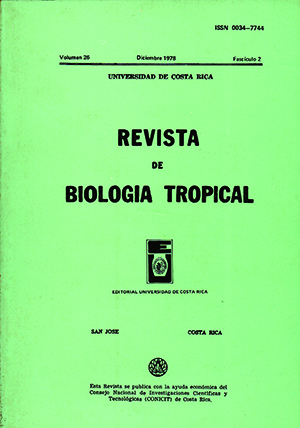Abstract
117 soil samples, collected at depths of0.0-0.25 m (surface horizon) and 1.0 ± 0.05 m (deep horizon), on the Aguas Zarcas quadrangle, seale 1 :50,000, and 44 samples derived from 8 soil profiles, were analyzed for variables: pH, P, K, Ca, Zn, Cu, Mn, Fe, Mg and Al. The analytical data were processed in an IBM 360/40 computer at the Centro de Informática, Universidad de Costa Rica.
A direct relationship was found between the K, Ca, P, Mg and Cu pedochemical patterns ofthe surface horizon and slightly lo none regarding pH, Al, Mn, Zn and Fe. Relationship between horizons as well as between elements was found only in connection with the Ca and Mg patterns.
Ca, P, Mg, Cu, Zn and Mn show low pedochemical patterns or lower in concentration than the corresponding critical levels, which should be studied in detail because of possible agronomical defficiences. The concentration ofthe Al, mostly lower than the "optimum level" (< 0.3 meq) suggests a relatively low toxicity incidence in the vegetation. Soils developed on the Aguacate and Buenavista formations tend to show a gradual decrease in deptll in K, Fe, Mg, Cu, Zn and Mn. The pH and the remaining elements: Ca, P, Mg and Al, show a rather irregular behavior. P, Ca, Mg, K, Fe and Mn, tend to display a generally higher concentration in soils originated on the Buenavista Formation, in contrast with the Aguacate Formation, which conversely lend lo show a higher content of Cu and Zn.
The tendency of part of the studied elements to concentrate in the surface horizon is evident and is apparently the inverse of the general behavior of the chemical elements in tropical latosols, possibly due too the intense influence of chemical weathering on the minerals constituting the soils that simultaneonsly impoverish these and enrich the solution.
References
AID Resources Inventory Center. 1965. Análisis Regional de Recursos Físicos Centroamérica y Panamá.
Castillo Muñol, R. 1977. Geoquímica ambiental de la Península de Nicoya, Costa Rica. Rev. Biol. Trop., 25: 219-255.
Costa Rica Instituto Meteorológico Nacional 1975. Boletín periódico, registros de precipitación y temperatura, San José, Costa Rica.
Institute of Geological Sciences 1974. G-EXEC Sytem, Users manual, Great Britain, Computer Unit.
Malavassi, E., & R. Madrigal. 1970. Reconocimiento geológico de la zona norte de Costa Rica. Dirección de Geología, Minas y Petróleo, Informes técnicos y Notas geológicas No. 38.
U. S. Geological Survey. 1969-1972. Environmental Geochemistry. Geochemical Survey of Missouri, plans and progress. Denver, Colorado.
##plugins.facebook.comentarios##

This work is licensed under a Creative Commons Attribution 4.0 International License.
Copyright (c) 1978 Revista de Biología Tropical






